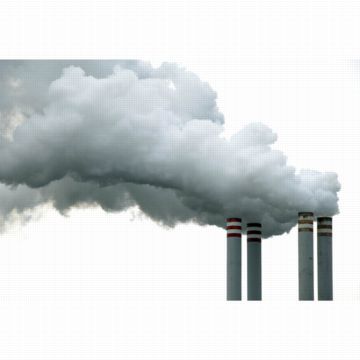Home > Press > Copper catalyst recycles carbon dioxide: Versatile reaction could help greenhouse gas become a more useful synthetic chemical
 |
| Figure 1: Carbon dioxide is a greenhouse gas which accelerates global warming—but it could also become a versatile synthetic chemical. |
Abstract:
RIKEN chemists have developed a catalyst that should allow carbon dioxide to be used as a versatile synthetic chemical.
Copper catalyst recycles carbon dioxide: Versatile reaction could help greenhouse gas become a more useful synthetic chemical
Japan | Posted on October 10th, 2008Carbon dioxide (CO2) is produced whenever fossil fuels are burned (Fig. 1), and it is a powerful greenhouse gas that traps heat in our atmosphere, contributing to global warming. As such, turning the gas into a chemical feedstock, rather than allowing it to escape into the atmosphere, is an extremely appealing idea.
In fact, industry has long used carbon dioxide as a chemical building block—in the manufacture of the painkiller aspirin, for example—but its use is limited by the difficulty of breaking open its strong carbon-oxygen double bonds.
Carbon compounds activated by lithium or magnesium are often needed to attack and incorporate carbon dioxide successfully, but these reagents are extremely reactive and quite hazardous on a large scale.
Chemists have recently developed milder, boron-based alternatives, which require a rhodium catalyst to speed up the reaction. Unfortunately, this catalyst tends to break down particularly sensitive chemical groups in the product.
Zhaomin Hou, of RIKEN's Advanced Science Institute, Wako, along with colleagues Takeshi Ohishi and Masayoshi Nishiura, has now developed a copper catalyst that helps the boron compounds to react with carbon dioxide without destroying sensitive chemical groups.
This makes the reaction particularly useful for building complex molecules containing several different types of chemical group, something that would not be possible with the harsh lithium reagents. "We have tried many different metal compounds, among which the copper catalyst was the best," says Hou.
The team was also able to study exactly how the catalyst works, by isolating key molecules at various intermediate stages of the reaction. They found that the active copper catalyst first displaces the boron group from the starting molecule, forming a new copper-carbon bond. Carbon dioxide then inserts itself into this bond before the copper catalyst is finally removed, leaving behind a carboxylic acid (-CO2H) group1.
Various forms of the boron compounds, known as boronic esters, are commercially available, says Hou. "And they can also be easily prepared in the lab."
Hou adds that their method is also amenable to large-scale, commercial synthesis. "Since CO2 is a renewable carbon resource, exploration of new reactions and catalysts for its efficient use is of great importance," he says. "One of our goals is to find a catalyst that can transform CO2 in exhaust gasses of automobile vehicles or chemical plants into useful materials."
Reference
1. Ohishi, T., Nishiura, M. & Hou, Z. Carboxylation of organoboronic esters catalyzed by N-heterocyclic carbene copper(I) complexes. Angewandte Chemie International Edition 47, 5792-5795 (2008).
The corresponding author for this highlight is based at the RIKEN Organometallic Chemistry Laboratory
####
For more information, please click here
Copyright © Riken
If you have a comment, please Contact us.Issuers of news releases, not 7th Wave, Inc. or Nanotechnology Now, are solely responsible for the accuracy of the content.
| Related Links |
| Related News Press |
News and information
![]() Simulating magnetization in a Heisenberg quantum spin chain April 5th, 2024
Simulating magnetization in a Heisenberg quantum spin chain April 5th, 2024
![]() NRL charters Navy’s quantum inertial navigation path to reduce drift April 5th, 2024
NRL charters Navy’s quantum inertial navigation path to reduce drift April 5th, 2024
![]() Discovery points path to flash-like memory for storing qubits: Rice find could hasten development of nonvolatile quantum memory April 5th, 2024
Discovery points path to flash-like memory for storing qubits: Rice find could hasten development of nonvolatile quantum memory April 5th, 2024
Chemistry
![]() What heat can tell us about battery chemistry: using the Peltier effect to study lithium-ion cells March 8th, 2024
What heat can tell us about battery chemistry: using the Peltier effect to study lithium-ion cells March 8th, 2024
![]() Nanoscale CL thermometry with lanthanide-doped heavy-metal oxide in TEM March 8th, 2024
Nanoscale CL thermometry with lanthanide-doped heavy-metal oxide in TEM March 8th, 2024
Announcements
![]() NRL charters Navy’s quantum inertial navigation path to reduce drift April 5th, 2024
NRL charters Navy’s quantum inertial navigation path to reduce drift April 5th, 2024
![]() Discovery points path to flash-like memory for storing qubits: Rice find could hasten development of nonvolatile quantum memory April 5th, 2024
Discovery points path to flash-like memory for storing qubits: Rice find could hasten development of nonvolatile quantum memory April 5th, 2024
Environment
![]() Billions of nanoplastics released when microwaving baby food containers: Exposure to plastic particles kills up to 75% of cultured kidney cells July 21st, 2023
Billions of nanoplastics released when microwaving baby food containers: Exposure to plastic particles kills up to 75% of cultured kidney cells July 21st, 2023
|
|
||
|
|
||
| The latest news from around the world, FREE | ||
|
|
||
|
|
||
| Premium Products | ||
|
|
||
|
Only the news you want to read!
Learn More |
||
|
|
||
|
Full-service, expert consulting
Learn More |
||
|
|
||








